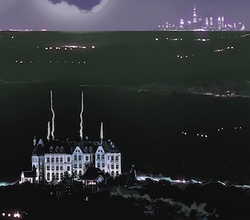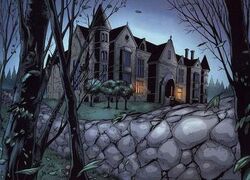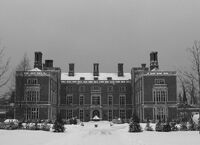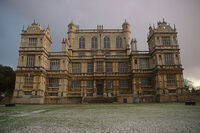| Wayne Manor | |
|---|---|
| Batman location | |
 Wayne Manor in Batman vol. 3 #16 (April 2017) Art by David Finch | |
| First appearance | Detective Comics #28 June 1939 |
| Created by | Bob Kane |
| Genre | Superhero comics |
| Information | |
| Type | Mansion |
| Notable locations | Gotham City |
| Notable characters | Bruce Wayne Thomas Wayne Martha Wayne Alfred Pennyworth Dick Grayson Barbara Gordon Jason Todd Timothy Drake Stephanie Brown Damian Wayne |
| Publisher | DC Comics |
Wayne Manor is a fictional American mansion appearing in American comic books published by DC Comics. It is the personal residence of Bruce Wayne, who is also the superhero Batman.
The residence is depicted as a large mansion on the outskirts of Gotham City and is maintained by the Wayne family's butler, Alfred Pennyworth. While the earliest stories showed Bruce Wayne buying the house himself, by the 1950s at the latest, retroactive continuity established that the manor had belonged to the Wayne family for several generations. Along with serving as a personal residence, the mansion houses the Batcave, which Batman uses as his secret headquarters. The vast majority of DC Comics references place Wayne Manor just outside of Gotham City in the state of New Jersey.[1][2][3][4]
In the 1960s television series, the narrator referred to the mansion as "stately Wayne Manor". For live-action films, English country house locations in Nottinghamshire, Hertfordshire, and Buckinghamshire, as well as Stevenson Taylor Hall in New York, have been used to depict Wayne Manor.
Mansion grounds[]

Wayne Manor with Gotham City in the distance from Detective Comics #967 (December 2017). Art by Álvaro Martínez and Raúl Fernández.
Wayne Manor is depicted as being on the outskirts of Gotham City in the state of New Jersey.[2][3][4][5] Comic book portrayals place the mansion within driving distance of Gotham City, close enough that the batsignal can be seen from Wayne Manor alerting Batman of distress in the city.
Wayne Manor's grounds include a front gate and walls around the parameter. Batman's subterranean headquarters, the Batcave, is located beneath the mansion. The Batcave is accessible from outside through a hidden entrance on the estate's grounds. This entrance leads directly to the Batcave and has been depicted in different forms, including a waterfall, pond, hologram, and camouflaged door.
Access to the Batcave[]
The manor grounds include an extensive subterranean cave system that Bruce Wayne discovered as a boy and later used as his base of operations, the Batcave. The method used to access it has varied across the different storylines in the comics, movies, and shows. In the comic books, it is typically accessible from a hidden door in Wayne Manor's study behind a non-functioning grandfather clock, which opens to a descending staircase when the hands on said clock are turned to 10:47, the time Thomas and Martha Wayne were killed.
The grounds also includes a large hill that was partially hollowed out for Batman's aerial vehicles, and there is also an underground river system that is large enough to accommodate docking space for the Batboat and has a large opening for said vehicle.
The Wayne Foundation Penthouse era[]

Wayne Manor in Batman and the Outsiders vol. 2, #13 (Jan. 2009). Art by Fernando Dagnino.
While these grounds are the regular home of Bruce Wayne, he temporarily vacated it in the stories from the late 1960s to the early 1980s, preferring to live in a penthouse apartment on top of the Wayne Foundation building in the city, which also included a secret sub-basement acting as a Batcave.
Wayne came to this decision when Dick Grayson went off to college, which led him to decide that the mansion was now impractical with only one resident and one servant. Furthermore, Wayne decided he wanted to be closer to his main field of operations in Gotham City than a home situated outside the main urban area would allow. However, by the early 1980s, Wayne came to reconsider that purpose and decided that being less accessible to the public was more advantageous for his Batman activities and returned to Wayne Manor.
Following the events of Cataclysm[]
During the events of Batman: Cataclysm a massive earthquake struck Gotham City, the epicenter of which was less than a mile from Wayne Manor. The mansion was seriously damaged, as was the cave network beneath. The ground beneath the mansion shifted significantly, and actually revealed the Batcave below, although the Bat-family were able to relocate all of Batman's equipment before official rescue came to the manor so that nobody would learn Bruce Wayne's secrets. The original Manor was damaged beyond repair, forcing Bruce Wayne to redesign the Manor along with the Batcave. The new Manor is a veritable fortress, a pastiche of Gothic architecture combined with features of castellated architecture. Solar panels are installed in the new Manor, providing environmentally-friendly electricity generation for the complex.[6] It also includes a heliport for commercial helicopters.[7]
Batman: The Return of Bruce Wayne[]
In Batman: The Return of Bruce Wayne it is revealed that Wayne Manor was designed by Nathan Van Derm for Darius Wayne, forming a stylized "W", although the additional gardens that existed at the time the manor was built add on to this symbol to create the image of a bat.
Batman Eternal/Arkham Manor[]
During Batman Eternal, Hush's machinations result in Wayne Enterprises being ruined and Bruce Wayne essentially bankrupt after the villain detonates various weapons caches Batman had concealed around Gotham.[8] As part of this bankruptcy, Wayne Manor is repossessed by the city and turned into the new Arkham Asylum following the destruction of the original,[9] but Bruce decides to accept this new status quo, reasoning that he can at least make sure that his enemies remain contained in the new manor given his intimate knowledge of its entrances and exits.[10]
The manor is eventually reclaimed by Bruce's lawyers, but it is temporarily left empty due to Bruce's death and amnesic resurrection as Alfred wanted to give Bruce a chance to have a life without Batman. However, Bruce returns to the manor when he realizes who he used to be.
Other versions[]
Vampire Batman[]
In Batman & Dracula: Red Rain, Wayne Manor is destroyed as part of a plan to destroy Dracula's vampire family, bombs exposing the interior of the Batcave to sunlight after Batman lured the vampires into the cave. Although the manor collapses into the cavern system after a second series of bombs are set off- thus concealing Bruce Wayne's secret - Batman and Alfred relocate to a brownstone in the center of town, Batman residing in a mausoleum in the basement while Alfred prepares his equipment in the main house. Although Alfred and Gordon stake Batman at the conclusion of Batman: Bloodstorm after he succumbs to his vampire instincts and drinks the Joker, he is restored to life after Alfred removes the stake, subsequently relocating to the catacombs underneath the remains of Wayne Manor. The manor's remains are finally destroyed for good when Gordon, Alfred, Two-Face, Killer Croc, and Two-Face's gang plant bombs on the cave roof, exposing the interior to sunlight and ending Batman's reign of terror once and for all.
Kingdom Come[]
In Kingdom Come, the Manor was mostly destroyed by Two-Face and Bane after Batman's true identity was exposed; the Batcave, however, remained relatively untouched. By the end of the graphic novel, the Manor has been rebuilt as a hospital/hospice for Gulag battle victims.
In other media[]
TV series[]
Batman[]
In the 1960s live action series, the exteriors were shot at 380 South San Rafael Avenue in Pasadena, California.[11][12] The interiors were shot at various soundstages. The primary passage to the Batcave from the manor was located in Bruce Wayne's study behind a bookshelf that retracted into the wall. The bookshelf was activated by a switch hidden in a bust of William Shakespeare. The bookshelf would disappear to reveal two labeled firepoles descending to the Batcave. Through an undisclosed mechanism, the poles allowed for Batman and Robin to go from their civilian garb to costume (the film based on the TV show shows a switch which initiates the change, though the process itself was never explained). The interiors and exterior of the Wayne Manor was also used in the original Mission: Impossible TV series episodes "Charity" and "The Visitors." It was used in 2016 for another superhero group as the residence of Hydra leader, Gideon Malick, in Marvel's Agents of S.H.I.E.L.D. on ABC.
Gotham[]
Webb Institute's Stevenson Taylor Hall reprises its earlier film role as Wayne Manor for the TV series Gotham.[13]
Live-action films[]

Knebworth House was used for the exterior of the 1989 Batman film

Stevenson Taylor Hall, Webb Institute in Glen Cove, New York was used as Wayne Manor in Batman Forever, Batman and Robin and TV Series Gotham.

Mentmore Towers was used for exterior shots in Batman Begins.

Wollaton Hall was used as Wayne Manor in The Dark Knight Rises.
Lambert Hillyer serial[]
The 1943 Batman serial originated the use of a grandfather clock as a door to the bat cave (or "bats’ cave" as it was called in the serial), a device which was then adopted by the comics. The austere bat cave featured only an ornate desk, on the wall behind which was projected the shape of a bat.
Spencer Gordon Bennet serial[]
1949's Batman and Robin serial showed little more of Wayne Manor than its predecessor did. It continued the use of the grandfather clock as a secret door to the bat cave, which boasted more accoutrements than in the 1943 serial, including a holding cell.
Tim Burton films[]
In 1989's Batman, Knebworth House, a Gothic Tudor mansion 28 miles (45 km) north of London was used for the exterior. The interior, however, is Hatfield House, Hertfordshire. The gaming room from the movie used the long gallery, and the marble hall was used for Wayne's "arsenal" with the two-way mirror. In Batman Returns (1992), an original scale model was used for the exteriors of Wayne Manor. In the sequel, the passageway to the Batcave is uncovered by turning on the lights of an ornament in a nearby aquarium and dropping through a false floor in an iron maiden, although Alfred does quip that he'll "take the stairs".
Joel Schumacher films[]
In Batman Forever (1995) and Batman & Robin (1997), Webb Institute in Glen Cove, New York was used for the exterior shots of Wayne Manor. In Batman Forever, Dick Grayson discovers an entrance to the Batcave concealed behind a silverware storage cupboard.
Christopher Nolan films[]
In the more recent Batman Begins (2005), the former Rothschild estate, Mentmore Towers in Buckinghamshire, was used to portray Wayne Manor's exterior and interior. In Batman Begins, the main part of the mansion is destroyed by fire caused by Ra's al Ghul, however its foundation survives intact and rebuilding efforts are underway as the film ends, with Alfred suggesting to Bruce to make improvements on the mansion's southeast corner (where the Batcave is located). The secret passage is an elevator shaft originally built as part of the Underground Railroad, accessed by playing three notes on a nearby piano.
In The Dark Knight (2008), Wayne Manor is still being reconstructed and is thus never seen, though it is briefly mentioned as being near the outer city limits in a neighborhood called the Palisades. Bruce Wayne relocates to a two-story tall penthouse apartment within a hotel he purchased, and his equipment is located in a different area: a secret bunker underneath a cargo container in a construction zone owned by Wayne Enterprises. The penthouse has a secret entrance to a location within the hotel where Wayne hides his equipment as Batman. According to the viral campaign, it is 25,000 sq ft (2,300 m2), with 40 ft (12 m) ceilings, two gigantic balconies, heliport for his private helicopter, and 360 degree view of the entire city. The monthly maintenance fee is around $31,000.
The reconstructed Wayne Manor has appeared in The Dark Knight Rises (2012) which takes place eight years after the events of The Dark Knight, and Wollaton Hall (which Mentmore Towers is a near replica of) in Nottingham as Wayne Manor's exterior and interior.[14][15][16] The Selina Kyle drawing room scene in The Dark Knight Rises was filmed in Osterley Park House in Hounslow, England, which is in a suburb of London. The film's drawing room is the real life mansion's entrance hall. The interior was designed by famed Neoclassical architect Robert Adam. At the end of the movie, after Bruce retires his role as Batman after fulfilling his vows to turn Gotham City into a city of order, he had his associates convert half of the manor into an orphanage, and named it after his parents, giving the other half to Alfred Pennyworth.
DC Extended Universe[]
Wayne Manor appears in Batman v Superman: Dawn of Justice. It has been abandoned for some time, after a large fire destroys most of the house, with Bruce and Alfred now residing within the "Glasshouse", a small modern mansion on the shores of a lake. Bruce visits his family's burial vault on the grounds of the mansion and briefly visits Wayne Manor's ruins before his battle with Superman.
Animation[]
DC Animated Universe[]
In Batman: The Animated Series, an address is given for Wayne Manor in the episode "The Demon's Quest" stating that it is located at 1007 Mountain Drive, Gotham. The design of the manor was similar to previous versions, but included many more art deco aspects, inside and outside. This version of the manor was built on a cliff overlooking the ocean. The unique shape of the main section's roof vaguely resembled the "ears" of the Batman symbol. The Justice League also visited the manor during the Thanagarian invasion to plan their next attack after escaping captivity. It was damaged during a Thanagarian invasion of the manor itself looking for the Justice League. Following the Thanagarian's defeat Alfred began repairs.
By the time of Batman: Beyond Wayne Manor is exactly the same from Batman: The Animated Series except with a few modern improvements. The inside of the Manor appears all but deserted and all possessions covered with blankets. The clock tower now opens with a pull of a lever in the clock.
In Epilogue the grandfather clock is attached to the wall with no supporting bottom and opens similar to an airlock.
The Batman[]
In The Batman, Wayne Manor is depicted as a much taller building, with 7 floors. The initial entrance was hidden behind a video game machine, but following later seasons the entrance was replaced with the traditional grandfather clock and a batpole.
Batman: The Brave and the Bold[]
In Batman: The Brave and the Bold, Wayne Manor can be seen briefly in the episode, "The Color of Revenge", where Batman and Robin use the pole to access the Batcave.
Batman: Under the Red Hood[]
Wayne Manor is briefly seen when Bruce digs up Jason's grave site which is located in the backyard.
Batman: Year One[]
Wayne Manor is seen in the background during Bruce's training and a visit by Lieutenant Gordon and his wife. The design is exactly the same design on the graphic novel of the same name Batman: Year One
Batman: The Dark Knight Returns Part 1 & 2[]
The design for Wayne Manor is the same one used in Batman: Year One. It served as the home and seclusion for Bruce Wayne after he retires from being Batman 10 years previously due to the death of Jason Todd due to unknown circumstances. It lost all power and ran on an emergency generator when Gotham's power outage and the rest of the United States after Superman deflects a Soviet nuclear missile causing an EMP pulse. Oliver Queen visited Bruce at the manor when planning to take down Superman. Wayne Manor was destroyed during Batman's final showdown with Superman in Gotham City after Alfred activated a self-destruct sequence. As the Manor burned to the ground Alfred looked on with sadness as he suffered a fatal stroke.
Justice League: The Flashpoint Paradox[]
Wayne Manor is seen in the alternate timeline as the home of Thomas Wayne. However it is heavily dilapidated and all but abandoned with Thomas who has taken on the role of Batman, following the murder of his son Bruce by Joe Chill and the descent into madness and transformation into the Joker by his wife Martha. The balcony of the Manor is where Thomas and Barry Allen attempt on two occasions to restore Barry's connection to the Speed Force. The design used for the manor is the same one used for Batman: Year One and Batman: The Dark Knight Returns animated films.
The Lego Batman Movie[]
Wayne Manor is featured in The Lego Batman Movie being located on an island called "Wayne Island". The entrance to the Batcave is accessed behind a fireplace.
Wayne Manor and Wayne Island are controlled by a HAL 9000-like version of the Batcomputer, here called "'Puter".
Inset map references[]
Some inset map references depict Wayne Manor as being south of U.S. 9, in the Bass River Township, New Jersey, area.
Video games[]
- In Injustice: Gods Among Us, Wayne Manor is seen in a parallel universe where Superman rules the world. Because Batman's Insurgency opposed him, Superman exposed his identity and had the manor cordoned off. Batman, accompanied by Green Arrow, Wonder Woman, Green Lantern and Aquaman from another universe, infiltrate Wayne Manor to access the Batcave to retrieve a kryptonite weapon to use against Superman.
Batman: Arkham[]
- Batman: Arkham City features several challenge maps set in Wayne Manor, including its main hall and armory.
- The interior of Wayne Manor is featured in the Batman: Arkham Origins DLC, Cold, Cold Heart, during Bruce Wayne's New Year's Eve party, which is crashed by Mister Freeze and Penguin's gang, who were searching for Ferris Boyle.
- Wayne Manor is briefly featured in Batman: Arkham Knight. After Scarecrow exposes Batman's identity to the world, a crowd of reporters had gathered outside the estate gates. The Dark Knight then returns to the manor to enact Knightfall Protocol. Soon after he is greeted by Alfred and steps inside, Wayne Manor is destroyed by a series of explosions, giving the world the impression that Batman had died.
References[]
- ↑ Amazing World of DC Comics #14, March 1974. DC Comics.
- ↑ 2.0 2.1 World's Finest Comics #259, October–November 1979. DC Comics.
- ↑ 3.0 3.1 Detective Comics #503 June 1983. DC Comics.
- ↑ 4.0 4.1 Atlas of the DC Universe, 1990. DC Comics.
- ↑ Amazing World of DC Comics #14, March 1974. DC Comics.
- ↑ Batman: The Ultimate Guide to The Dark Knight
- ↑ Batman: Gotham Knights #1
- ↑ Batman Eternal #37
- ↑ Arkham Manor #1
- ↑ Arkham Manor #6
- ↑ "Bing Maps". Maps.live.com. Retrieved 2010-12-25.<templatestyles src="Module:Citation/CS1/styles.css"></templatestyles>
- ↑ "Historic homes". Retrieved 14 September 2012.<templatestyles src="Module:Citation/CS1/styles.css"></templatestyles>
- ↑ "Webb Institute: Lenfest Gallery Upgrade". Retrieved 6 April 2014.<templatestyles src="Module:Citation/CS1/styles.css"></templatestyles>
- ↑ "The Dark Knight Rises finds new home for Batman in Nottingham". Metro.co.uk (Associated Newspapers Limited). 10 June 2011. http://www.metro.co.uk/film/865934-the-dark-knight-rises-finds-new-home-for-batman-in-nottingham. Retrieved 20 August 2012.
- ↑ Heath, Neil (16 June 2011). "Batman boost as The Dark Knight Rises at Wollaton Hall". BBC News (BBC). http://www.bbc.co.uk/news/uk-england-nottinghamshire-13679676. Retrieved 18 July 2012.
- ↑ "City was paid for Batman filming". This is Nottingham (Northcliffe Media). 30 June 2011. http://www.thisisnottingham.co.uk/City-paid-Batman-filming/story-12854596-detail/story.html. Retrieved 20 August 2012.
External links[]
| Batman (TV series) | ||
|---|---|---|
| Characters adapted for the series |
Alfred • Batgirl / Barbara Gordon • Batman / Bruce Wayne • Catwoman • Clock King • Commissioner James Gordon • Green Hornet • The Joker • Kato • The Mad Hatter • Mr. Freeze • The Penguin • The Riddler • Robin / Richard "Dick" Grayson | |
| Characters created for the series |
Egghead • King Tut | |
| Episodes | "Hi Diddle Riddle" • "Smack in the Middle" • "Fine Feathered Finks" • "The Penguin's a Jinx" • "The Joker Is Wild" • "Batman Is Riled" • "Instant Freeze" • "Rats Like Cheese" • "Zelda the Great" • "A Death Worse Than Fate" • "The Joker Goes to School" • "He Meets His Match, The Grisly Ghoul" • "True or False-Face" • "Holy Rat Race" • "The Penguin Goes Straight" • "Not Yet, He Ain't" • "Shoot a Crooked Arrow" • "Walk the Straight and Narrow" • "Hot Off the Griddle" • "The Cat and the Fiddle" • "Marsha, Queen of Diamonds" • "Marsha's Scheme of Diamonds" • "The Zodiac Crimes" • "The Joker's Hard Times" • "The Penguin Declines" • "Enter Batgirl, Exit Penguin" • "The Londinium Larcenies/The Foggiest Notion/The Bloody Tower" | |
| Vehicles & gadgetry | Batmobile • Batboat • Batcopter • Batcycle • Batsuit • Batphone • Batcomputer • Batbelt | |
| In-story locations | Gotham City • Batcave • Wayne Manor | |
| Related topics | Shows | Legends of the Superheroes • The New Adventures of Batman • The Green Hornet |
| Films | Batman • Return to the Batcave: The Misadventures of Adam and Burt • Batman: Return of the Caped Crusaders • Batman vs. Two-Face | |
| Other | "Batman Theme" • "Holy..." • Batman '66 • Batman XXX: A Porn Parody • Bat Pussy • Batusi | |